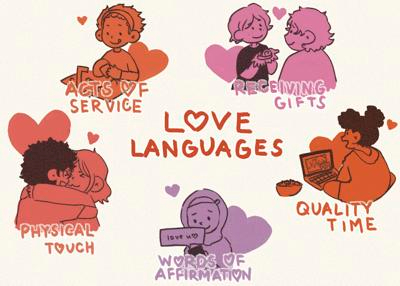Love Languages

February 14, 2023
What are the five love languages?
What is a love language and why does it matter?
Love languages are the different ways of expressing and receiving love. It’s important to communicate and understand how you and others feel loved because it will create a better understanding between you and your partner. Additionally, people must remember that not everyone experiences and expresses love the same way. By being considerate of how each person communicates love and experiences love, relationships can become stronger and more fulfilling overall. In fact, love languages extend past romantic relationships, therefore understanding this form of communication can help people become better friends and family members as well.
What Are the Five Love Languages?
- Words of affirmation – words mean a lot to you, you like reassurance
Examples: telling you how much they care or appreciate you, “ good job,” compliments, or “I love you.”
2. Acts of service – if actions speak louder than words to you, this is most likely your love language.
Examples: they do something for you without being asked, like running an errand for you
3. Receiving gifts – you like it when people get you gifts. If you say you don’t like people spending money on you (and actually mean it) this is probably not your love language.
Examples: Your partner gets you a necklace, stuffed animal, snacks
4. Quality time – spending time together. You give each other your undivided attention.
Examples: Deep/meaningful conversations, going on dates, traveling together, watching a movie
5. Physical touch – when you feel comfortable when people express their love for you through touch
Examples: holding hands, kissing, hugging
The Numbers: What are the most and least popular love languages?
1,000 adults were surveyed to see how these love languages were ranked in the U.S. In a recent study 38% of people ranked quality time as their primary love language. Most participants were women: 41% (aged 45 and under) and 44% (older than 45). This is followed by physical touch (24% of adults) which is often preferred as a primary love language by men over women. The remaining love languages ranked in the following order: words of affirmation (19%), acts of service (13%), and gift giving (7%)
(Orth and Sanders).
Most people don’t share a love language with their partner. It is likely for someone to have the same love language as their partner because the higher the percentage is, the more likely they are to align. Two people who share quality time as their love language are more likely to match.
How do I know what my love language is?
Your love language is what type of love you like to receive. Your love language reflects what makes you feel the most appreciated and cared about. You can have more than one love language, but it is important to establish what your primary love language is. Lastly, there are two love languages – how you receive love and how you show love. For example, you can like to show love by giving gifts, but have your love language (to receive love) as words of affirmation. Everyone will have different expectations, especially when it comes to receiving love.
Want to find your love language? Take this quiz!
https://www.garbo.io/quizzes/love-language-quiz
Sources:
https://www.mindbodygreen.com/articles/what-is-my-love-language-quiz







